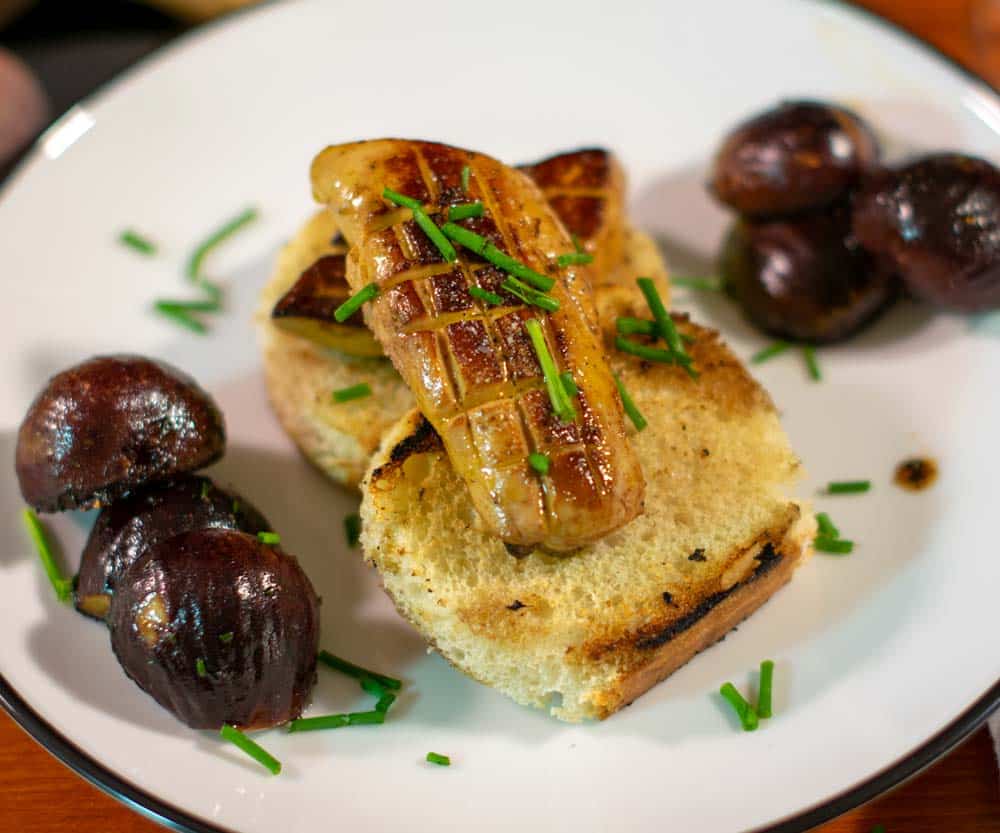#foiegras #fig #French #food #luxury
“There is no food like foie gras, every bite brings an unsurpassed and indescribable flavor, and it melts in your mouth”— Paul Ebeling
Foie gras, fatty liver in French is 1 of the world’s most popular delicacies. It combines a heavenly sweet taste with a silky texture that many of us find unparalleled.
The art of raising ducks and geese for foie gras demands a low-stress environment. It is produced by a few small farmers in the United States and many more around the world, especially France by tube-feeding ducks or geese by hand 2X a day for 2 wks prior to processing. This simulates their natural propensity to gorge themselves in preparation for migration and results in an enlarged liver with a sweet, rich taste and smooth-as-butter texture.
Ancient Egyptians discovered the secret of the delicacy when hunting migratory ducks and geese in the waters of the Nile River. In nature, these birds gorge themselves prior to long migrations. They store the resulting extra calories in their livers and skin as fat, and use it as fuel during the journey. After migration, the size of their livers returns to normal.
Egyptians took advantage of the migratory geese that wintered in the Nile delta and domesticated them fairly early. The goose also figured prominently in their creation myths, with the god Geb, who had the head of a goose. Later the goose became associated with the god Amon, whose priests raised geese near the temples for sacrificial offerings, and for food, as Herodotus noted with surprise in the 5h-Century BC. Geese were depicted in tomb paintings as an important part of daily life, diet, and medicine. In the necropolis of Saqqara, dating around 2500 BC, there is a painting that shows the force feeding of geese. Egyptians valued the meat, the fat and the liver of the goose.
From Egypt the practice spread across the Mediterranean to Greece, where Homer mentions geese being fed wheat soaked in water in the Odyssey, and ultimately to Rome, where culinary history really gets exciting. It was in Rome that cooking was elevated from a job for slaves to an art form. In the 3rd Century BC the Romans discovered that feeding some types of fruit to the birds further enhanced the taste of foie gras. It was likely the Romans that began raising geese for the specific purpose of creating foie gras, and for the 1st time gave it a special name, iecur ficatum, meaning “fig-stuffed liver.” Pliny the Elder comments in his Natural History on the practice of feeding figs to geese to fatten them, as does Cato, who describes the technique being used on farmyard hens too.
From Greece and Rome, foie gras spread to Europe, especially France, largely through the influence of Jews who used goose and duck fat as their cooking medium of choice. They fattened their birds to produce both foie gras and cooking fat. In the 1500s foie gras became widely accepted by gastronomes across Europe. The French are the largest producers and consumers of foie gras, and the Southwest of France is well known for traditional foie gras production.
In the mid-1980s Ariane Daguin, founder of D’Artagnan introduced fresh, domestically-raised foie gras to America, which until then had only been available as a canned product. She sold foie gras to top restaurants in New York with classically trained chefs in the kitchens, and then to retailers and home chefs across the country. With her Gascogne background and a famous chef for a father she taught America about foie gras.
Here are my tips for Foie Gras with Fig: This seared foie gras recipe highlights the rich flavors and sublime texture that show why this is 1 of the most sought after ingredients in the culinary world. Since foie gras can be an ingredient that intimidates lots of cooks at home and in restaurants, and is something that very few people work with often, this is how to prepare and sear it and have created a dish that shows off its super qualities.
If you are working with a whole liver, 1st separate the 2 lobes, removing any extra veins, and slicing the liver into 3/4 to 1in thick slices.
Whenever your slicing foie gras, make sure to run the knife under scalding hot water. Heating the knife allows it to slice through the foie like a hot knife through cold butter, creating nice even edges and reducing waste.
The Key to getting a good sear is to have a heavy enough pan that it can be heated over high heat and hold its heat when the slices hit the pan. The hotter the pan, the less fat will render out as it cooks.
The challenge is to get the slices to warm through and brown before they render out. When it is cooked too long foie will melt in the pan.
INGREDIENTS
- 2 slices grade A foie gras – approximately 3oz each
- 2 slices good country bread, French or Italian, cut into circles using a large biscuit cutter
- 3 figs, cut in half
- ⅓ cup cognac
- 1/2 tbsp honey
- ½ tbsp chives, minced
- ½ tsp thyme, minced
- ½ tsp salt
- ¼ tsp pepper
INSTRUCTIONS
- Use a large biscuit cutter to cut 2 circles from ½ inch thick slices of good country bread.
- In a small bowl, combine the salt and pepper.
- Cut the figs in half and lightly salt and pepper them.
- In a small bowl mix the figs, honey, thyme, and cognac together. Let the figs marinate for at least 15 mins.
- Use a hot knife to slice the foie gras into 3/4 to 1 in thick slices
- Make small criss-cross cuts in each slice before seasoning them with salt and pepper.
- Sear the foie gras in a large cast-iron pan that has been preheated over high heat. The pan should be dry and extremely hot. The slices should be seared until they are golden brown, this usually takes 30 to 60 secs per side.
- Once the slices have finished searing, set them on a paper towel, and lightly season them with pink salt and cracked Java pepper.
- Quickly toast the bread in the pan, it only needs to be toasted for 30 to 45 secs per side.
- Place the figs cut side down to caramelize in the pan. After a minute or two, add in the marinade for the figs and any fat that has rendered out and been removed. Cook until the figs have caramelized and the sauce starts to thicken.
- To plate the dish set the toasted bread in the middle of the plate, laying the slices of foie on top. Place the figs around the outside, drizzling the sauce from the pan over the figs.
- Top with a sprinkling of chives.
My tips
- Prep everything before starting the cooking process.
- Combining the pink salt and fresh cracked Java pepper in a small bowl, so you can use your fingers to season everything as it s cooking.
- Run the knife under hot water before cutting each slice.
- Use a dry cast iron or heavy-bottomed sauté pan.
- Have a plate with a paper towel ready for the slices when they come out of the pan.
The honey and cognac highlight the warm, almost caramel-like interior, while the caramelized figs provide a textural contrast and a burst of citrus that elevate the rest of the dish’s flavors. Adding the chives gives it a a bit of color.
Serving everything on top of a slice of toasted country bread brings everything together, balancing each bite. The plating for this dish is designed so it can be served as a whole portion to a person you really like.
Pair with a Sauterne, it is considered the ultimate pairing for foie gras, its waxy sweet mouthfeel complimenting the rich creaminess of foie gras.
Eat healthy, Be healthy, Live lively









